Evaluation of Zero-Energy Building and Use of Renewable Energy in Renovated Buildings: A Case Study in Japan
Abstract
:1. Introduction
2. Outline of Research
2.1. Overview of ZEB in Japan
2.2. Building Overview
2.3. Equipment Overview
3. Evaluation of Energy Consumption Using the Building Energy Simulation Tool (BEST)
3.1. Outline of BEST Program
3.2. Outline of Simulation
3.3. Simulation Results
3.4. Actual Measurement Results of Annual Primary Energy Consumption in the Target Building
3.5. Investigation on Use of Surplus Electricity On-Site
4. Discussion
5. Conclusions
Author Contributions
Funding
Institutional Review Board Statement
Informed Consent Statement
Acknowledgments
Conflicts of Interest
References
- UNFCCC. The Paris Agreement. 2015. Available online: https://unfccc.int/files/essential_background/convention/application/pdf/english_paris_agreement.pdf (accessed on 3 June 2021).
- UNEP. Emissions Gap Report; United Nations Environment Programme: Nairobi, Kenya, 2019; Available online: https://wedocs.unep.org/bitstream/handle/20.500.11822/30797/EGR2019.pdf?sequence=1&isAllowed=y (accessed on 30 June 2020).
- Prime Minister’s Office, Japan. Available online: https://www.kantei.go.jp/jp/99_suga/statement/2020/1026shoshinhyomei.html (accessed on 3 June 2021).
- Ministry of the Environment, Japan: Basic Materials on the Paris Agreement. Available online: https://www.env.go.jp/earth/odanka/cop/shiryo.html#03 (accessed on 3 June 2021).
- Ministry of Economy. Trade and Industry: Summary of Press Conference, Japan. Available online: https://www.meti.go.jp/speeches/kaiken/2020/20201026001.html (accessed on 3 June 2021).
- Ministry of the Environment, Japan: Greenhouse Gas Emissions. Available online: https://www.env.go.jp/earth/ondanka/ghg.html (accessed on 3 June 2021).
- Alonso, M.J.; Liu, P.; Mathisen, H.M.; Ge, G.; Simonson, C. Review of heat/energy recovery exchangers for use in ZEBs in cold climate countries, Building and Environment. Build. Environ. 2015, 84, 228–237. [Google Scholar] [CrossRef]
- Building Energy data book. In The Buildings Technologies Program, Energy Efficiency and Renewable Energy US; EERE: Washington, DC, USA, 2008; p. 2009.
- Mavromatidisa, G.; Orehounigb, K.; Bollingerb, L.A.; Hohmannb, M.; Marquanta, J.F.; Miglania, S.; Morvaja, B.; Murraya, P.; Waibela, C.; Wanga, D.; et al. Ten questions concerning modeling of distributed multi-energy systems. Build. Environ. 2019, 165, 106372. [Google Scholar] [CrossRef]
- IEA. Energy Technology Perspectives 2017: Catalysing Energy Technology Transformations, International Energy Agency; Organisation for Economic Cooperation and Development: Typeset, France, 2017. [Google Scholar] [CrossRef] [Green Version]
- Cornaro, C.; Pierro, M.; Puggioni, V.A.; Roncarati, D. Outdoor Characterization of Phase Change Materials and Assessment of Their Energy Saving Potential to Reach NZEB. Buildings 2017, 7, 55. [Google Scholar] [CrossRef] [Green Version]
- Cellura, M.; Ciulla, G.; Guarino, F.; Longo, S. Redesign of a Rural Building in a Heritage Site in Italy: Towards the Net Zero Energy Target. Buildings 2017, 7, 68. [Google Scholar] [CrossRef] [Green Version]
- Asdrubalia, F.; Ballarinib, I.; Corradob, V.; Evangelistia, L.; Grazieschic, G.; Guattaria, C. Energy and environmental payback times for an NZEB retrofit. Build. Environ. 2019, 147, 461–472. [Google Scholar] [CrossRef]
- Ascione, F.; Bianco, N.; de Masi, R.F.; Mastellone, M.; Vanoli, G.P. Phase Change Materials for Reducing Cooling Energy Demand and Improving Indoor Comfort: A Step-by-Step Retrofit of a Mediterranean Educational Building. Energies 2019, 12, 3661. [Google Scholar] [CrossRef] [Green Version]
- Buratti, C.; Moretti, E.; Zinzi, M. High Energy-Efficient Windows with Silica Aerogel for Building Refurbishment: Experimental Characterization and Preliminary Simulations in Different Climate Conditions. Buildings 2017, 7, 8. [Google Scholar] [CrossRef] [Green Version]
- Danza, L.; Barozzi, B.; Bellazzi, A.; Belussi, L.; Devitofrancesco, A.; Ghellere, M.; Salamone, F.; Scamoni, F.; Scrosati, C. A weighting procedure to analyse the Indoor Environmental Quality of a Zero-Energy Building. Build. Environ. 2020, 183, 107155. [Google Scholar] [CrossRef]
- Panagiotidou, M.; Fuller, R.J. Progress in ZEBs—A review of definitions, policies and construction activity. Energy Policy 2013, 62, 196–206. [Google Scholar] [CrossRef]
- Zhang, W.; Huang, F.; Mao, K.; Lin, C.; Pan, Z. Evaluation of Photovoltaic Energy Saving Potential and Investment Value of Urban Buildings in China Based on GIS Technology. Buildings 2021, 11, 649. [Google Scholar] [CrossRef]
- Saarloos, B.A.; Quinn, J.C. Net-Zero Energy Districts and the Grid: An Energy-Economic Feasibility Case-Study of the National Western Center in Denver, CO, USA. Buildings 2021, 11, 638. [Google Scholar] [CrossRef]
- Wang, C.; Wang, Q.; Nourozi, B.; Piesk, H.; Ploski, A. Evaluating the cooling potential of a geothermal-assisted ventilation system for multi-family dwellings in the Scandinavian climate. Build. Environ. 2021, 204, 108114. [Google Scholar] [CrossRef]
- Liu, X.; Li, C.; Zhang, G.; Zhang, L.; Wei, B. Numerical Investigation on Energy Efficiency of Heat Pump with Tunnel Lining Ground Heat Exchangers under Building Cooling. Buildings 2021, 11, 611. [Google Scholar] [CrossRef]
- Liu, G.; Wang, Z.; Li, C.; Hu, S.; Chen, X.; Liang, P. Heat exchange character and thermal comfort of young people in the building with solar radiation in winter. Build. Environ. 2020, 179, 106937. [Google Scholar] [CrossRef]
- IRENA. Renewable Power Generation Costs in 2018; IRENA: PAbu Dhabi, United Arab Emirates, 2019; Available online: https://www.irena.org/publications/2020/Jun/Renewable-Power-Costs-in-2019 (accessed on 3 June 2021).
- Zhang, Y.; Vand, B.; Baldi, S. A Review of Mathematical Models of Building Physics and Energy Technologies for Environmentally Friendly Integrated Energy Management Systems. Buildings 2022, 12, 238. [Google Scholar] [CrossRef]
- Bland, A.; Khzouz, M.; Statheros, T.; Gkanas, E.I. PCMs for Residential Building Applications: A Short Review Focused on Disadvantages and Proposals for Future Development. Buildings 2017, 7, 78. [Google Scholar] [CrossRef] [Green Version]
- Weger, L.; Abánades, A.; Butler, T. Methane cracking as a bridge technology to the hydrogen economy. Int. J. Hydrogen Energy 2017, 42, 720–731. [Google Scholar] [CrossRef] [Green Version]
- Schneider, S.; Bajohr, S.; Graf, F.; Kolb, T. State of the Art of Hydrogen Production via Pyrolysis of Natural Gas. ChemBioEng Rev. 2020, 7, 150–158. [Google Scholar] [CrossRef]
- Muradov, N. Hydrogen via methane decomposition: An application for decarbonization of fossil fuels. Int. J. Hydrogen Energy 2001, 26, 1165–1175. [Google Scholar] [CrossRef]
- International Energy Agency. Net Zero by 2050: A Roadmap for the Global Energy Sector. 2021. Available online: https://www.iea.org/events/net-zero-by-2050-a-roadmap-for-the-global-energy-system (accessed on 3 July 2021).
- Jacobson, M.Z.; Delucchi, M.A. Providing all global energy with wind, water, and solar power, Part I: Technologies, energy resources, quantities and areas of infrastructure, and materials. Energy Policy 2011, 39, 1154–1169. [Google Scholar] [CrossRef]
- International Energy Agency. Getting Wind and Solar onto the Grid: A Manual for Policy Makers; International Energy Agency: Paris, France, 2017; Available online: https://www.iea.org/reports/getting-wind-and-solar-onto-the-grid (accessed on 10 July 2021).
- Ministry of the Environment, Japan. ZEB Definition. Available online: https://www.env.go.jp/earth/zeb/detail/01.html (accessed on 3 June 2020).
- Institute for Building Environment and Energy Conservation (IBEC). Building Energy Simulation Tool (BEST). Available online: https://www.ibec.or.jp/best/ (accessed on 3 June 2020).
- Japan Meteorological Agency. Automated Meteorological Data Acquisition System. Available online: https://www.jma.go.jp/jma/kishou/know/amedas/kaisetsu.html (accessed on 3 June 2020).
- Smolinka, T.; Günther, M.; Garche, J. Stand und Entwicklungspotential der Wasserelektrolyse zur Herstelliung von Wasserstoff aus regenerativen Energien: Kurzfassung und Abschlussbericht. 2011. Available online: https://www.now-gmbh.de/wp-content/uploads/2020/09/now-studie-wasserelektrolyse-2011.pdf (accessed on 10 July 2020).
- Ministry of Economy. Trade and Industry: Prospects and Challenges for Hydrogen Production. Available online: https://www.meti.go.jp/committee/kenkyukai/energy/suiso_nenryodenchi/co2free/pdf/002_04_00.pdf (accessed on 3 February 2022).
- Keenan, J.H. Steam Tables: Thermodynamic Properties of Water Including Vapor, Liquid and Solid Phases; English Units; Wiley: New York, NY, USA, 1969. [Google Scholar]
- Institute of Electrical Engineers of Japan. Open Symposium: Utilization of Renewable Energy and Grid Interconnection. Available online: http://denki.iee.jp/?page_id=14878 (accessed on 3 February 2022).
- Leadership in Energy and Environmental Design (LEED). Available online: https://www.usgbc.org/leed (accessed on 20 June 2021).
- Building Research Establishment Environmental Assessment Method (BREEAM). Available online: https://www.breeam.com/ (accessed on 20 June 2021).
- Suzer, O. Analyzing the compliance and correlation of LEED and BREEAM by conducting a criteria-based comparative analysis and evaluating dualcertified projects. Build. Environ. 2019, 147, 158–170. [Google Scholar] [CrossRef]
- Comprehensive Assessment System for Built Environment Efficiency (CASBEE). Available online: https://www.ibec.or.jp/CASBEE/english/ (accessed on 22 July 2021).
- Agency for Natural Resources and Energy, ZEH (Zero Energy House). Available online: https://www.enecho.meti.go.jp/category/saving_and_new/saving/general/housing/index03.html (accessed on 20 June 2021).
- Ecoschools. Available online: https://www.ecoschools.global/ (accessed on 20 June 2021).
- Díaz-López, C.; Serrano-Jiménez, A.; Lizana, J.; López-García, E.; López-García Engineer, E.; Molina-Huelva, M.; Barrios-Padura, A. Passive action strategies in schools: A scientific mapping towards eco-efficiency in educational buildings. J. Build. Eng. 2022, 45, 103598. [Google Scholar] [CrossRef]
- Vadiee, A.; Dodoo, A.; Jalilzadehazhari, E. Heat Supply Comparison in a Single-Family House with Radiator and Floor Heating Systems. Buildings 2020, 10, 5. [Google Scholar] [CrossRef] [Green Version]
- Energy Plus. Available online: https://www.energy.gov/eere/buildings/downloads/energyplus-0 (accessed on 20 June 2021).
- eQUEST. Available online: https://www.doe2.com/equest/ (accessed on 20 June 2021).
- Institute for Building Environment and Energy Conservation (IBEC). Web Program. Available online: https://www.kenken.go.jp/becc/ (accessed on 3 June 2020).
- Agency for Natural Resources and Energy. Renewable Energy and Stable Supply. Available online: https://www.enecho.meti.go.jp/about/special/johoteikyo/saiene_anteikyokyu.html (accessed on 5 June 2021).
- De Santoli, L.; Basso, G.L.; Nastasi, B. The Potential of Hydrogen Enriched Natural Gas deriving fromPower-to-Gas option in Building Energy Retrofitting. Energy Build. 2017, 149, 424–436. [Google Scholar] [CrossRef]
- Verbecke, F.; Vesy, B. Safety strategy for the first deployment of a hydrogen-based green public building in France. Int. J. Hydrogen Energy 2013, 38, 8053–8060. [Google Scholar] [CrossRef]
- The Research Centre on Zero Emission Neighborhoods. Available online: https://fmezen.no (accessed on 3 July 2021).
- Hermesmann, M.; Müller, T.E. Green, Turquoise, Blue, or Grey? Environmentally friendly Hydrogen Production in Transforming Energy Systems. Prog. Energy Combust. Sci. 2022, 90, 100996. [Google Scholar] [CrossRef]

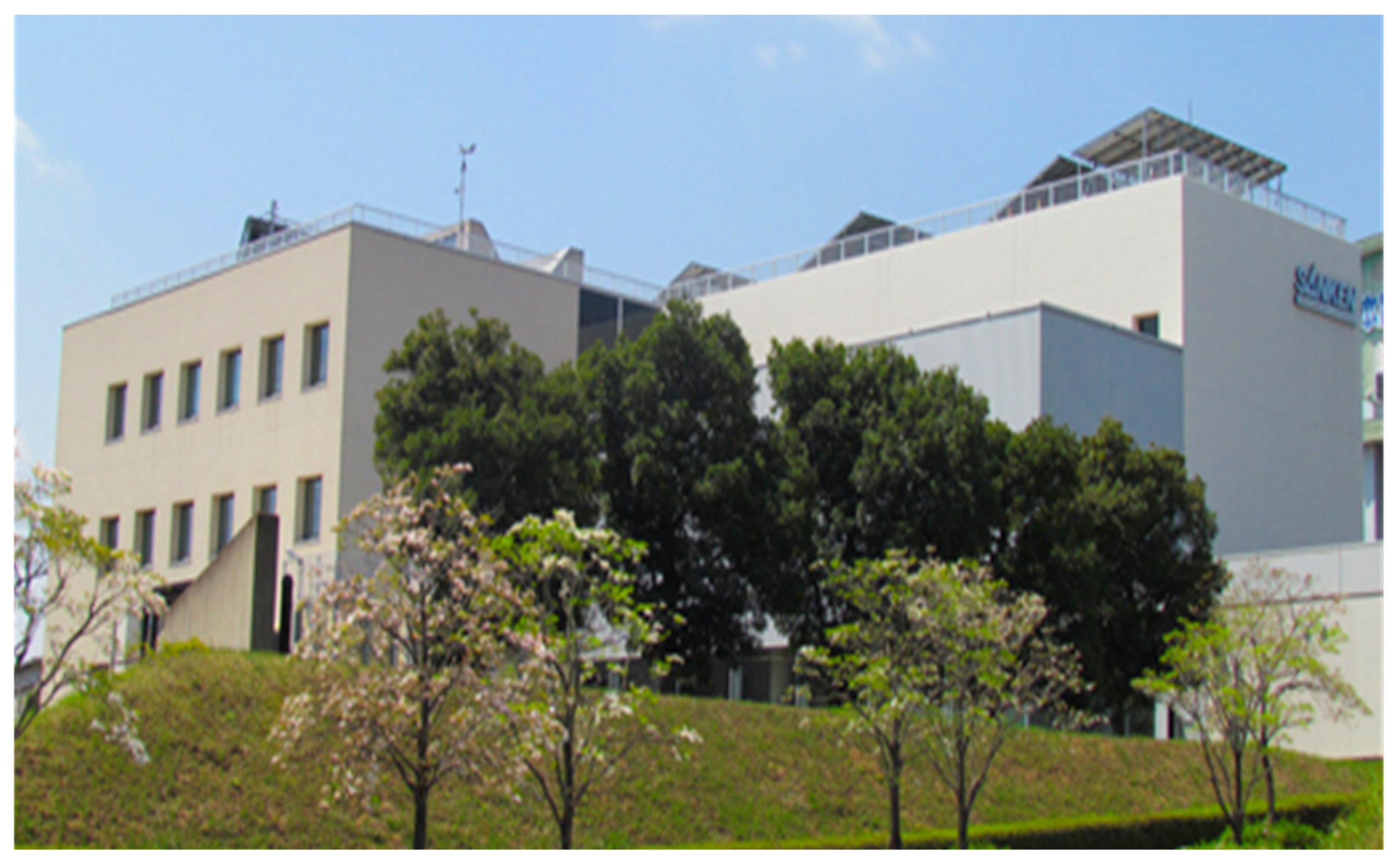

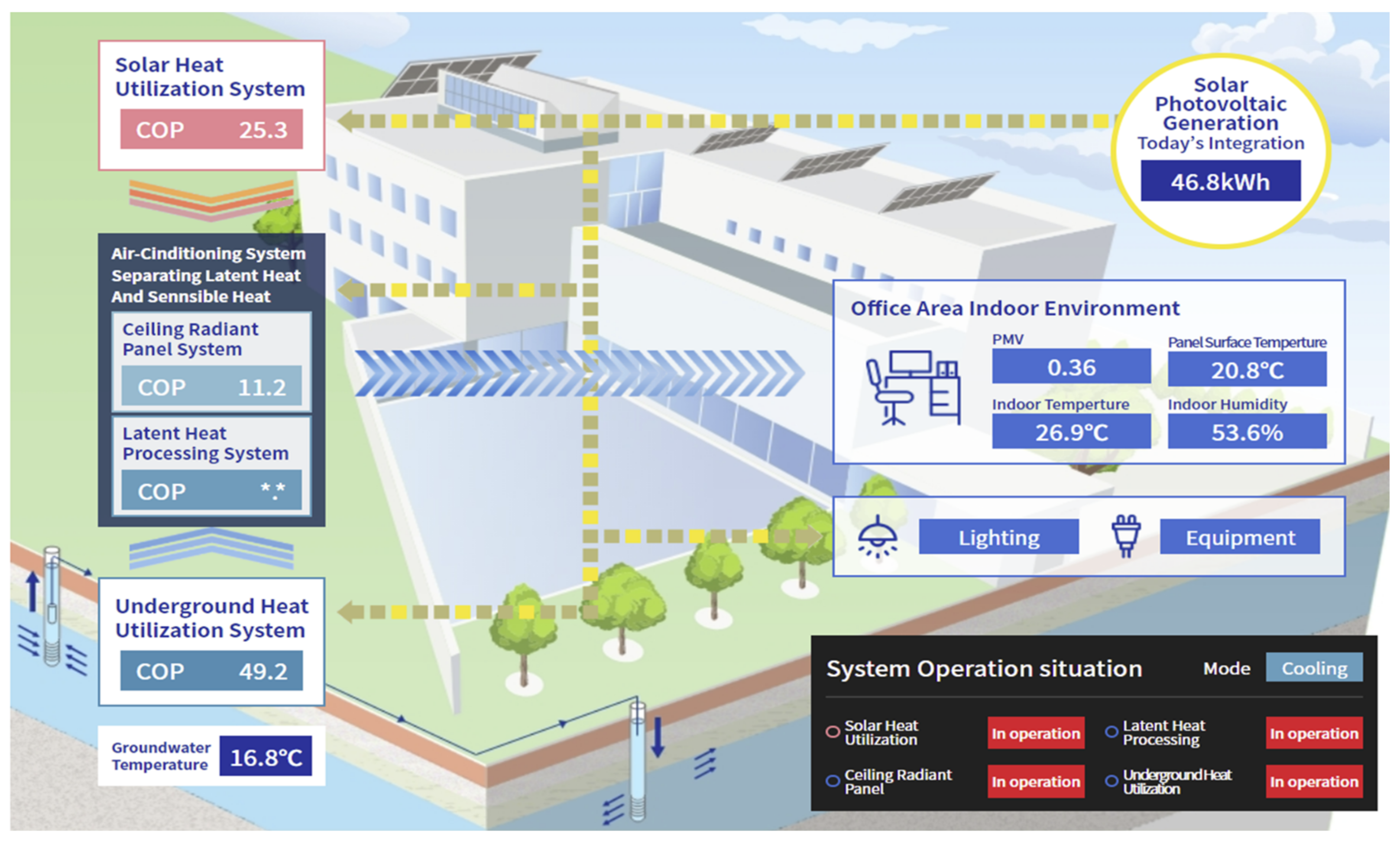
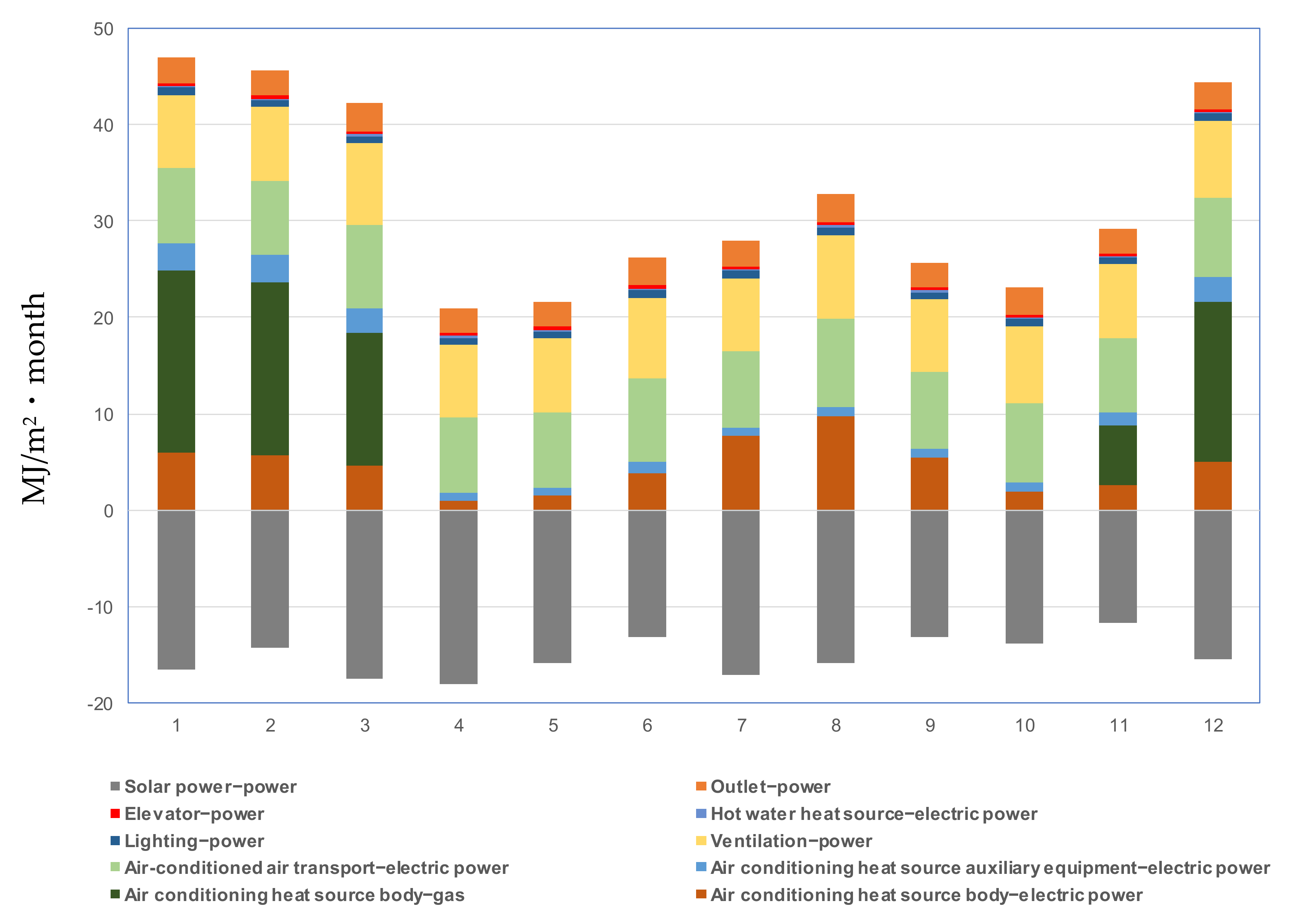
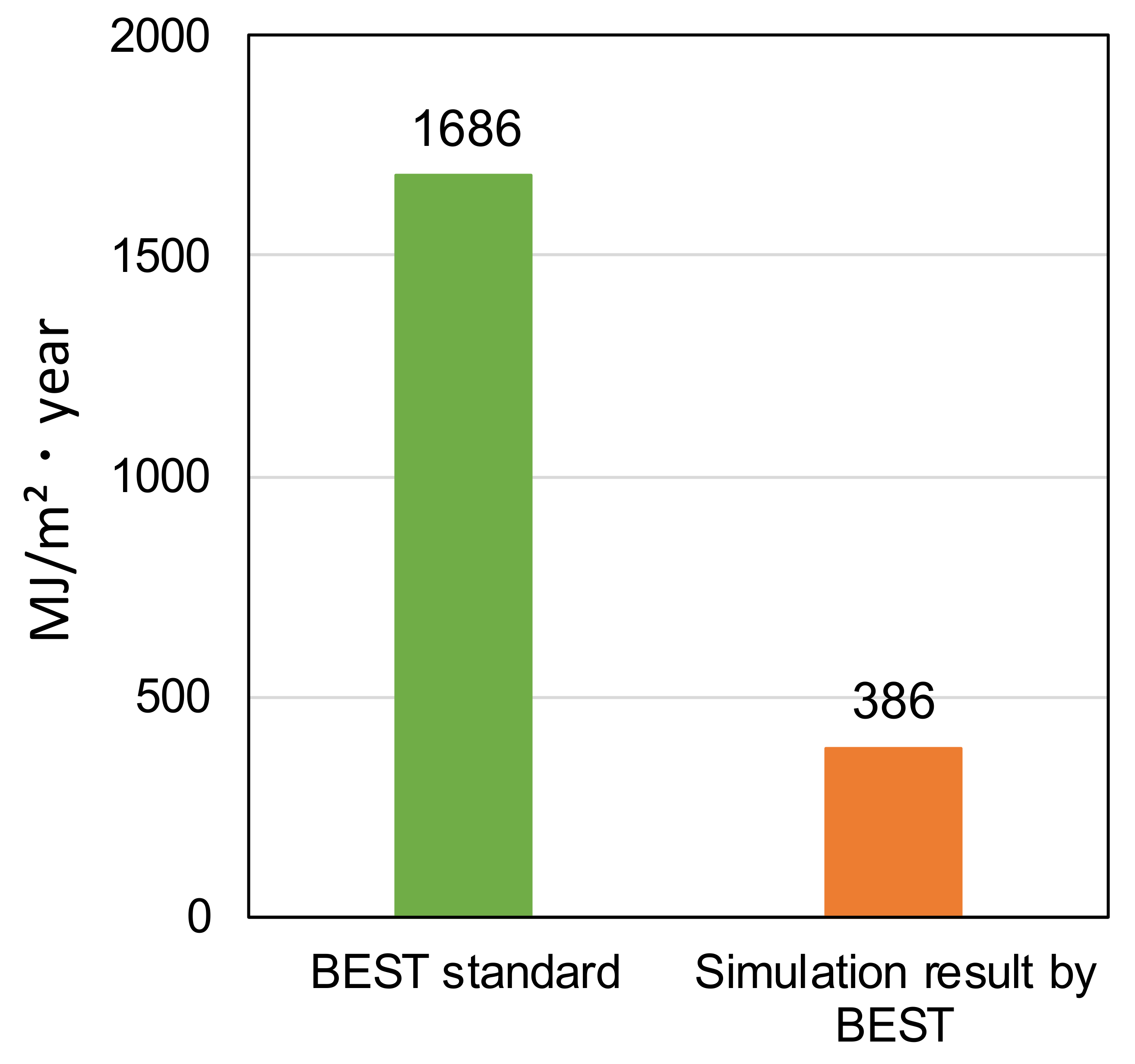




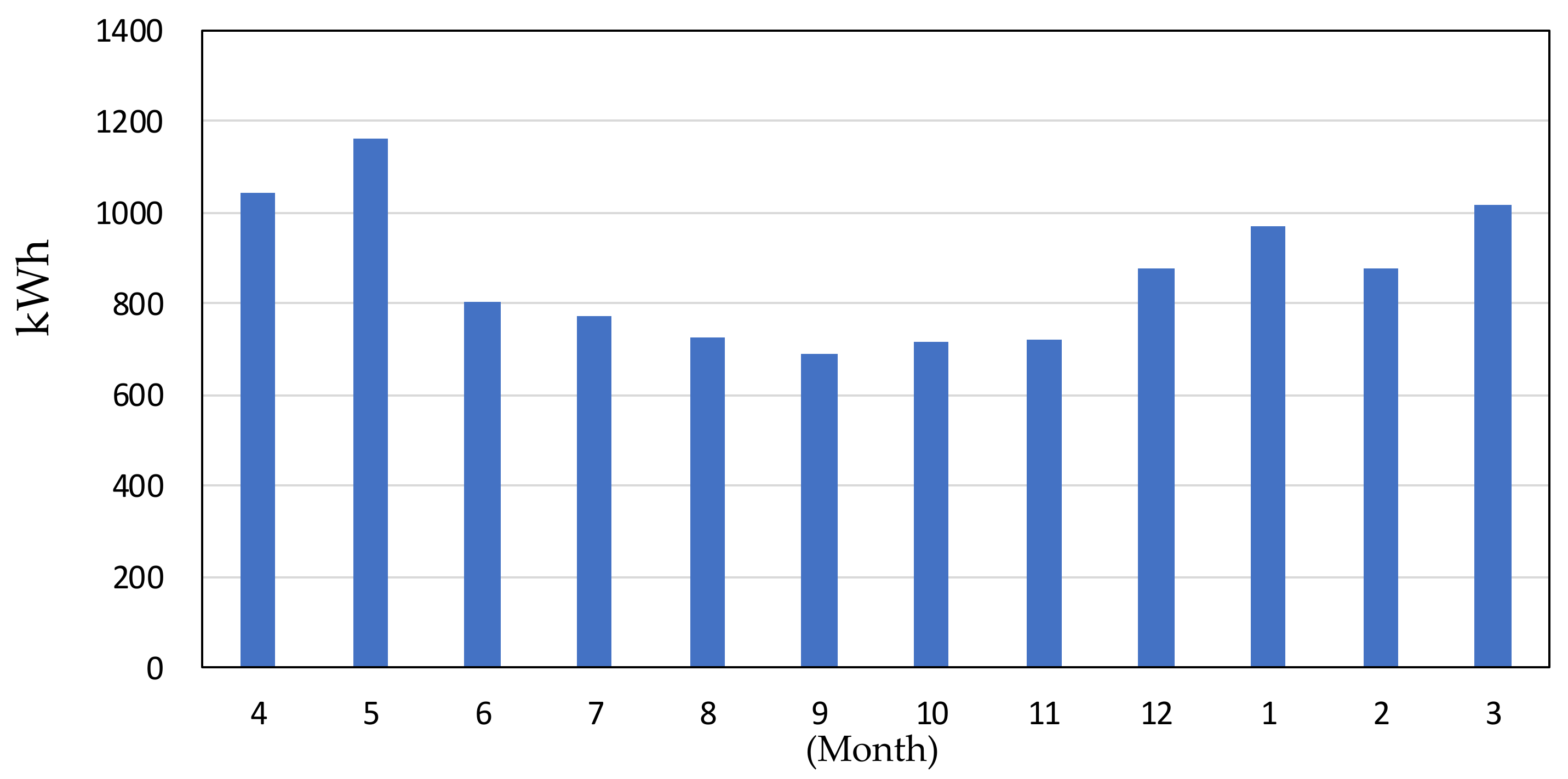

| Location | Ibaraki Prefecture |
| Building area | 1101.53 m2 |
| Total floor area | 2258.65 m2 |
| Height of the building | 13.7 m, Base floor height: 4.0 m |
| Construction | RC construction |
| Floor | 3 floors |
| Heat source | Use of geothermal heat Solar thermal panels Air-cooled heat pump Water source heat pump |
| Air conditioning | AHU + Single duct Packaged air conditioner (air heat source) |
| Ventilation | Living room area: No. 1 ventilation unit Restrooms: No. 3 ventilation unit |
| Lighting | LED Lights |
| Elevator | One hydraulic elevator |
| Air-cooled heat pump | Cooling capacity: 85 kW, Heating capacity: 85 kW Cold water volume: 244 L/min (usual) 12→7 °C Hot water volume: 244 L/min (usual) 40→45 °C |
| Water source heat pump | Cooling capacity: 20 kW, Heating capacity: 24 kW Cold water volume: 70 L/min (19.1→15.0 °C) Hot water volume: 60 L/min (30.0→36.0 °C) Cooling water volume: 70 L/min (22.0→27.0 °C) Heat source water volume: 395 L/min (12.0→7.0 °C) |
| Solar thermal panels | Heat collecting area: 2.0 m2, Circulating water volume: 3 L/min |
| Air-cooled heat pump | Cooling capacity: 85 kW, Heating capacity: 85 kW Cold water volume: 244 L/min (usual) 12→7 °C Hot water volume: 244 L/min (usual) 40→45 °C |
| Water source heat pump | Cooling capacity: 20 kW, Heating capacity: 24 kW Cold water volume: 70 L/min (19.1→15.0 °C) Hot water volume: 60 L/min (30.0→36.0 °C) Cooling water volume: 70 L/min (22.0→27.0 °C) Heat source water volume: 395 L/min (12.0→7.0 °C) |
| Solar thermal panels | Heat collecting area: 2.0 m2, Circulating water volume: 3 L/min |
| Meteorological data | Japan, The Automated Meteorological Data Acquisition System (AMeDAS) |
| Insulation performance | Urethane foam insulation (70 mm), Thermal conductivity:0.028 W/m·K |
| Window glass | Low-E Double glazing (Thermal transmission rate: 2.48 W/m2·K) |
| Air conditioning system | Air conditioning time 8:30~18:00 Cooling period July~September (28 °C, 60% RH) Heating period November~March (20 °C, 40% RH) |
| Internal heat generation | Personnel density 0.1 (person/m2) Lighting heat generation 16.3 (W/m2) Heat generation of electrical equipment 12 (W/m2) |
| Lighting | Light-emitting diode (LED) |
Publisher’s Note: MDPI stays neutral with regard to jurisdictional claims in published maps and institutional affiliations. |
© 2022 by the authors. Licensee MDPI, Basel, Switzerland. This article is an open access article distributed under the terms and conditions of the Creative Commons Attribution (CC BY) license (https://creativecommons.org/licenses/by/4.0/).
Share and Cite
Kuwahara, R.; Kim, H.; Sato, H. Evaluation of Zero-Energy Building and Use of Renewable Energy in Renovated Buildings: A Case Study in Japan. Buildings 2022, 12, 561. https://doi.org/10.3390/buildings12050561
Kuwahara R, Kim H, Sato H. Evaluation of Zero-Energy Building and Use of Renewable Energy in Renovated Buildings: A Case Study in Japan. Buildings. 2022; 12(5):561. https://doi.org/10.3390/buildings12050561
Chicago/Turabian StyleKuwahara, Ryoichi, Hyuntae Kim, and Hideki Sato. 2022. "Evaluation of Zero-Energy Building and Use of Renewable Energy in Renovated Buildings: A Case Study in Japan" Buildings 12, no. 5: 561. https://doi.org/10.3390/buildings12050561





